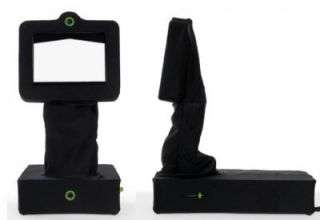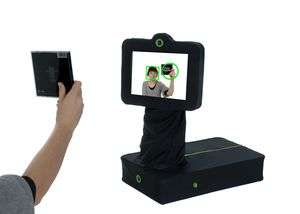Wizkid changes concept of how people interact with machines

There's a kid waiting to meet you at The Museum of Modern Art in New York. Like any kid, it will amuse you, it will ask you lots of questions, and it might even bother you a little bit. But unlike most kids, it doesn’t walk or talk, and it pays perfect attention. Meet Wizkid: part computer, part robot, a Swiss kid who's changing our concept of how people interact with machines.
Wizkid is part of MoMA's Design and the Elastic Mind exhibit, running from February 24 to May 12, 2008. This unusual device is the result of a collaboration between an engineer, Fréderic Kaplan and an industrial designer, Martino d’Esposito. Kaplan, a researcher at EPFL (Ecole Polytechnique Federale de Lausanne), worked ten years for Sony, creating "brains" for entertainment robots. D’Esposito, who teaches at ECAL (The University of Art and Design Lausanne), designs objects and furniture for several companies including Ligne Roset and Cinna. Their collaboration was supported by the new EPFL+ECAL Lab, a joint initiative of the two Lausanne-based institutions that aims to merge engineering, design and architecture in new and innovative ways.

Wizkid looks like a computer with a neck. But there the similarities with the familiar personal computer end. Wizkid isn't static. The screen on the mobile neck moves about like a head, and it's trained to hone in on human faces. Once it sees you, Wizkid focuses on you and follows your movement. Unlike a computer, which requires you to stop what you're doing and adapt your behavior and social interactions in order to use it, Wizkid blends into human space. There’s no mouse and no keyboard. You don’t touch anything. There’s no language getting in the way. On Wizkid’s screen you see yourself surrounded by a “halo” of interactive elements that you can simply select by waving your hands. If you move away or to one side, Wizkid adapts itself to you, not the other way around. If you’re with a friend, Wizkid finds and tracks both of you and tries to figure out your relationship, expressing surprise, confusion or enjoyment when it gets your response.
Wizkid’s inventors see their creation as playing a new and important role in the transitional world we currently inhabit. “Wizkid gets us AFK – away from keyboard – and back into the physical world, ” explains Kaplan. “Unlike a personal computer, it doesn’t force the human to accommodate, and it’s fundamentally social and multi-user.”
Kaplan isn’t suggesting that Wizkid will replace the language-driven interfaces of ordinary computers. But he does believe that there are many areas in which Wizkid’s augmented reality could ease and enhance the human experience. Hold up your favorite CD cover and Wizkid will start the stereo. Play novel kinds of games. Browse products in a store or information in a museum exhibit without having to touch a screen. In the office, Wizkid adds a new dimension to conferences, paying attention to who is speaking (and who is not).
Unlike a real kid, whose learning curve can be frustratingly hard to influence, Wizkid learns as much as you want it to about you and your world, and interacts with you at a level that you define. Creature of habit" Wizkid will keep track of your preferences, and anticipate some light jazz when you walk in the door. Want to use this device simply as a tool" Adjust a slider on its side and Wizkid will follow you without making any suggestions.
At the MoMA exhibit, Wizkid will interact with visitors; ask (nonverbal) questions about relationships; and use its novel "body language" to express interest, confusion, and pleasure. If you go out of range, and then come back, Wizkid might just remember you and try to continue the conversation. It’s different and slightly unsettling at first, because we’re so used to adapting ourselves to the restricted physical scope of computers and to interacting with them through language and touch. So stretch your mind, and let this new kid on the block surprise you!
For more information on Wizkid: www.wizkid.info
Source: Ecole Polytechnique Fédérale de Lausanne





















